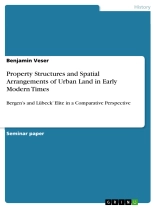Seminar paper from the year 2007 in the subject History Europe – Other Countries – Middle Ages, Early Modern Age, grade: A (1, 0), University of Bergen (Department of History), course: Urbanisering I Nordeuropa 1000-1750, language: English, abstract: Property is one of the key elements of the structure in a town. Not only does it tell us about the owner of urban space who might have had influence through this property, but also who lived on this property. It is interesting if the owner of the property is identical with the one who lived on the land and the one who owned the house. By studying these topics, conclusions of the social structure of a town can be drawn. It is the idea of space, certainly not without the consideration of time, that leads to historical knowledge in a way of multidimensional understanding.
Here this is examined by comparing the two Hansa towns Bergen and Lübeck. Two towns that supposedly show similar economic and demographic structures. Thus differences can be made more obvious. To get a narrow and exact view on the topic only the elite of the town, the social group we know most about through the sources, is regarded.
It is worth knowing how external effects like economical changes as well as social developments and demographical evolutions may had impact on urban structures like for example such of property of land or buildings. The focus should be on the question how the political and economic elites did compete this challenges in the regarded time period from the 16th to the 18th century and what was the impact on property structures.
It was important for the leading groups to be present in the town centre for different reasons (e.g. the need for control), but what exactly was the place of the elite? How important was property of urban land for the leading groups in the Early Modern times? Did they keep their urban property or are there changes of property to be regarded during this period? Finally are there huge differences between Bergen and Lübeck, two towns that on a first view seem to be so likewise?
On the way to answer these questions some general considerations about urban theories and especially spatial arrangements are made. Further the question of what defines the elite and what are the settings in Norwegian and German society is elaborated including theoretical considerations on the topic. The economic and social changes in both countries are as well outlined before the towns are separately discussed. The society and its determination is regarded as well as urban space in connection with property and living space.
Here this is examined by comparing the two Hansa towns Bergen and Lübeck. Two towns that supposedly show similar economic and demographic structures. Thus differences can be made more obvious. To get a narrow and exact view on the topic only the elite of the town, the social group we know most about through the sources, is regarded.
It is worth knowing how external effects like economical changes as well as social developments and demographical evolutions may had impact on urban structures like for example such of property of land or buildings. The focus should be on the question how the political and economic elites did compete this challenges in the regarded time period from the 16th to the 18th century and what was the impact on property structures.
It was important for the leading groups to be present in the town centre for different reasons (e.g. the need for control), but what exactly was the place of the elite? How important was property of urban land for the leading groups in the Early Modern times? Did they keep their urban property or are there changes of property to be regarded during this period? Finally are there huge differences between Bergen and Lübeck, two towns that on a first view seem to be so likewise?
On the way to answer these questions some general considerations about urban theories and especially spatial arrangements are made. Further the question of what defines the elite and what are the settings in Norwegian and German society is elaborated including theoretical considerations on the topic. The economic and social changes in both countries are as well outlined before the towns are separately discussed. The society and its determination is regarded as well as urban space in connection with property and living space.
Language English ● Format PDF ● Pages 21 ● ISBN 9783640102648 ● File size 0.9 MB ● Publisher GRIN Verlag ● City München ● Country DE ● Published 2008 ● Edition 1 ● Downloadable 24 months ● Currency EUR ● ID 4001520 ● Copy protection without












